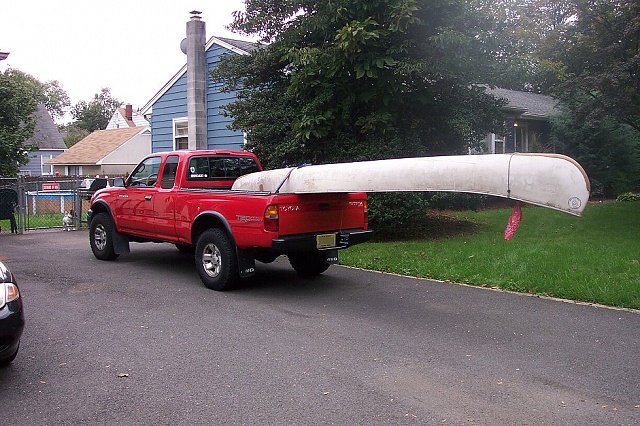Transporting a canoe can be tricky without the right method. Using a truck bed is a smart choice.
It’s convenient and secure. Many paddlers struggle with loading their canoe. They often worry about damage or instability during transport. Luckily, there are effective ways to put a canoe in a truck bed. Learning the best techniques ensures your canoe stays safe and secure.
Whether you’re heading to a serene lake or a rushing river, knowing how to load your canoe properly makes your trip smoother. This guide will help you understand the best methods and tips for securing your canoe. So, let’s dive in and make your next adventure hassle-free.

Credit: www.reddit.com
Choosing The Right Truck
Pick a truck that fits your canoe. A small truck might not be enough. Measure the truck bed length. Compare it with your canoe length. This helps avoid problems. A larger bed is often better. It gives more space. You can secure the canoe easily.
A truck bed liner is useful. It protects the bed. The liner prevents scratches. Also, look for tie-down points. These points are crucial. They help keep the canoe in place. Some trucks have special bed features. These can make loading easier. Check for bed extenders too. Extenders can add extra length. This is helpful for long canoes.
Preparing The Canoe
Check the canoe for any cracks or holes. Look at the bottom and sides. Make sure the canoe is safe. Repair any damage before use.
Remove any loose items from the canoe. Paddles and life jackets should be stored separately. Secure everything tightly to avoid loss or damage.
Loading Equipment
You need some basic items for safe canoe loading. A strong rope or straps keep the canoe in place. These items prevent the canoe from moving. A loading mat helps too. It protects the truck bed. This mat also makes sliding the canoe easier.
Use protective padding to avoid damage. Place padding on the truck bed. This keeps the canoe safe. Padding also protects the truck. Towels or foam blocks work well. Make sure they are securely placed. Proper padding makes transport smoother and safer.
Positioning The Canoe
Place the canoe in the truck bed at a slight angle. This helps to maximize the space and keep the canoe secure. The back end of the canoe should rest on the truck bed. The front end should extend over the tailgate. Use soft padding to protect the canoe and truck. Avoid sharp angles which could damage the canoe.
Ensure the weight is evenly distributed. Heavy items should be placed near the center. This prevents the canoe from tipping or shifting. Secure the canoe with straps or ropes. Tighten the straps to keep the canoe in place. Regularly check the straps during the trip.
Securing The Canoe
Place the canoe in the truck bed. Ensure it is centered. Use strong straps to secure the canoe. Attach the straps to the truck bed hooks. Tighten the straps. Check if the canoe moves. Use more straps if needed. Always tie down both ends of the canoe. This prevents movement during travel. Double-check all connections. Safe travel is important.
Push the canoe lightly. Check if it shifts. It should not move. Test the straps. They should be tight. Look for loose ends. Tie them securely. Check during travel stops. Ensure the canoe stays in place. Safety first always.
Driving Safely
Drive at a steady speed. Avoid sudden stops or starts. It helps keep the canoe stable. Fast speeds can make the canoe shift. Go slower on bumpy roads. Check your mirrors often. Make sure the canoe stays in place. Short drives are easier with a loaded truck bed. Long drives need more care and planning. Extra stops may be needed.
Use strong straps to secure the canoe. Check the straps often. Tighten them if needed. Wide turns are safer. Tight turns can make the canoe move. Be careful while backing up. The canoe can block your view. Use a friend to guide you if possible. Park in safe spots. Avoid parking on slopes. Always double-check the canoe before driving.
Unloading The Canoe
First, loosen the straps that hold the canoe. Make sure they are completely off before moving the canoe. Be careful not to rush this step. Double-check to ensure all straps are removed. Straps can be tricky sometimes. Take your time.
Use your legs to lift, not your back. Bend your knees and keep your back straight. This way, you avoid injury. Lift slowly and steadily. It’s best if you have a friend to help you. Teamwork makes it easier. Use both hands to support the canoe. Balance is key. Move the canoe to the ground gently.
Credit: www.ridgelineownersclub.com
Maintaining Equipment
Inspect your canoe often. Look for any cracks or damage. Check the truck bed too. Ensure no sharp edges are present. Fix any issues right away. Regular inspections keep your equipment in good shape. Healthy equipment lasts longer. Safety is also ensured.
Store your canoe properly. Use a soft pad or blanket. Avoid direct sunlight. Sunlight can damage the canoe. Keep the truck bed clean. Dirt and debris can cause scratches. Store equipment away from moisture. Moisture can lead to rust and mold. Proper storage maintains the canoe’s quality.

Credit: www.f150forum.com
Frequently Asked Questions
How To Transport A Canoe In A Truck Bed?
Secure the canoe with ratchet straps. Place the canoe diagonally in the truck bed. Use foam blocks or padding to prevent damage. Attach a red flag to the rear for visibility.
How Do You Put A Canoe On A Truck Without A Rack?
Place the canoe upside down on the truck bed. Use foam blocks or pool noodles to protect the vehicle. Secure it with strong straps, tying them tightly to anchor points. Check stability before driving.
How To Load A Canoe On Top Of A Truck?
Place the canoe beside the truck. Lift one end onto the roof rack. Push the canoe forward until fully loaded. Secure it with straps.
How Far Can A Canoe Stick Out Of A Truck?
A canoe can stick out 4 feet beyond the rear bumper of a truck. Ensure it is properly flagged for safety.
Conclusion
Securing your canoe in a truck bed is straightforward. Use straps for stability. Position the canoe with care. Make sure it’s centered. Protect the canoe and truck. Check the setup before driving. Follow these steps for a safe journey. Happy paddling!

